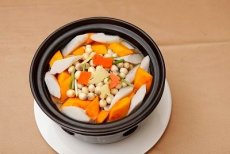
All iLive content is medically reviewed or fact checked to ensure as much factual accuracy as possible.
We have strict sourcing guidelines and only link to reputable media sites, academic research institutions and, whenever possible, medically peer reviewed studies. Note that the numbers in parentheses ([1], [2], etc.) are clickable links to these studies.
If you feel that any of our content is inaccurate, out-of-date, or otherwise questionable, please select it and press Ctrl + Enter.
Hepatitis A diet
Medical expert of the article
Last reviewed: 04.07.2025

Since the liver plays a leading role in metabolism, the appointment of a rational diet has long been given great importance in the complex therapy of viral hepatitis. However, if earlier most recommendations justified the need for a predominantly carbohydrate diet with a significant restriction of proteins and especially fats, now it can be considered generally accepted that the diet for hepatitis A should be complete, high-calorie and, if possible, physiological. The ratio of proteins, fats and carbohydrates should be 1:1:4-5.

It has been shown that long-term restriction of animal proteins and fats in the diet prolongs the period of convalescence, reducing the body's resistance, regenerative and glycogen-forming function of the liver. On the other hand, a diet rich in protein enhances glycogen synthesis in the liver and prevents the development of fatty degeneration of hepatocytes. Dietary fats, especially dairy and vegetable fats, serve as the main energy material, a source of energy in the body, they ensure the biosynthesis of phospholipids of cell membranes and the synthesis of fat-soluble vitamins, and impart taste to food. Consequently, for the normal functioning of liver cells and the enhancement of their regeneration, a sufficient amount of proteins and fats in the diet of patients corresponding to the physiological norm is necessary.
Diet for hepatitis A is gentle (in terms of cooking and exclusion of irritants), table No. 5
What should you not eat if you have hepatitis A?
For 6 months after discharge, special attention should be paid to nutrition, which should be sufficiently complete with the complete exclusion of substances harmful to the liver. You should eat regularly during the day every 3-4 hours, avoiding overeating. Alcoholic beverages (including beer) are strictly prohibited.
The diet for hepatitis A excludes extractive substances, refractory fats (lard, margarine, combined fat), fatty sausages, pork, rinds, canned meat, raw eggs, fatty poultry, fatty fish, spicy sauces, marinades, legumes (peas, beans), spicy cheeses, garlic, radish, radish, chocolate, cakes, pastries, candies, hot seasonings (mustard, pepper, mayonnaise), smoked meats, mushrooms, nuts, almonds, horseradish, etc.
What can you eat if you have hepatitis A?
Proteins are introduced into the diet in the form of cottage cheese, milk, kefir, lean meats (beef, veal, chicken), lean fish (cod, pike perch, navaga, pike, etc.), omelette, low-fat cheeses. Fats are also given in the form of butter and vegetable oil (corn, olive, sunflower).
Carbohydrates - in the form of rice, semolina, oatmeal, buckwheat porridge, bread, pasta, sugar, potatoes, etc.
The daily diet should include a sufficient amount of raw and boiled vegetables (carrots, cabbage, cucumbers, beets, tomatoes, green peas, zucchini), greens, fruits, and juices.
At the same time, honey, jam, pastila, cookies made from unleavened dough, dried apricots, blackthorn, raisins, mousses, jellies, kissels, salads, vinaigrettes, soaked herring, jellied fish in gelatin are allowed.
In the presence of symptoms of intoxication, it is especially recommended to drink plenty of weak tea, tea with milk, lemon, chalk, jam, rosehip infusion, fruit and berry juices, compotes, alkaline mineral waters, and 5% glucose solution.
The recommendations presented can be considered only indicative, since when prescribing a diet in each specific case, it is necessary to take into account many factors, among which the patient's age, severity of the condition, and stage of the pathological process are of great importance. It is also necessary to take into account individual food tolerance, national and personal habits. Obviously, in the acute phase of the disease, especially in the first days, when the symptoms of intoxication are most pronounced and the patient may have complete anorexia combined with nausea and vomiting, the diet for hepatitis A should be as gentle as possible, excluding fats and limiting animal proteins. Patients in this period receive mainly fruit juices, fruits, kefir, cottage cheese, sweet tea, jelly, milk porridges and other products at will. Forced feeding is not allowed, since this leads to an increase in dyspeptic manifestations. Such restrictions in the diet are justified only in moderate and severe forms of the disease for several days; in mild and especially in atypical forms, they are not indicated. It is also inappropriate to administer them in cases where the patient is admitted to hospital with a decline in clinical manifestations, regardless of the severity of the pathological process.
In accordance with modern concepts of hepatitis A as a benign disease that does not lead to the development of chronic hepatitis, the recommendations of past years on the need to adhere to dietary restrictions for 6 months from the onset of the disease should also be considered outdated. In the vast majority of patients, complete restoration of the liver structure and function occurs within 2-3 months from the onset of the disease, and a longer correction of the diet is pathogenetically unjustified. It is clear that dietary restrictions should be removed individually, taking into account not only the functional state of the liver, but also the presence of possible disorders of the biliary tract and gastroduodenal pathology.
It is also obvious that in the case of a protracted course of the disease, the diet for hepatitis A should be maintained throughout the entire pathological process in the liver.


 [
[